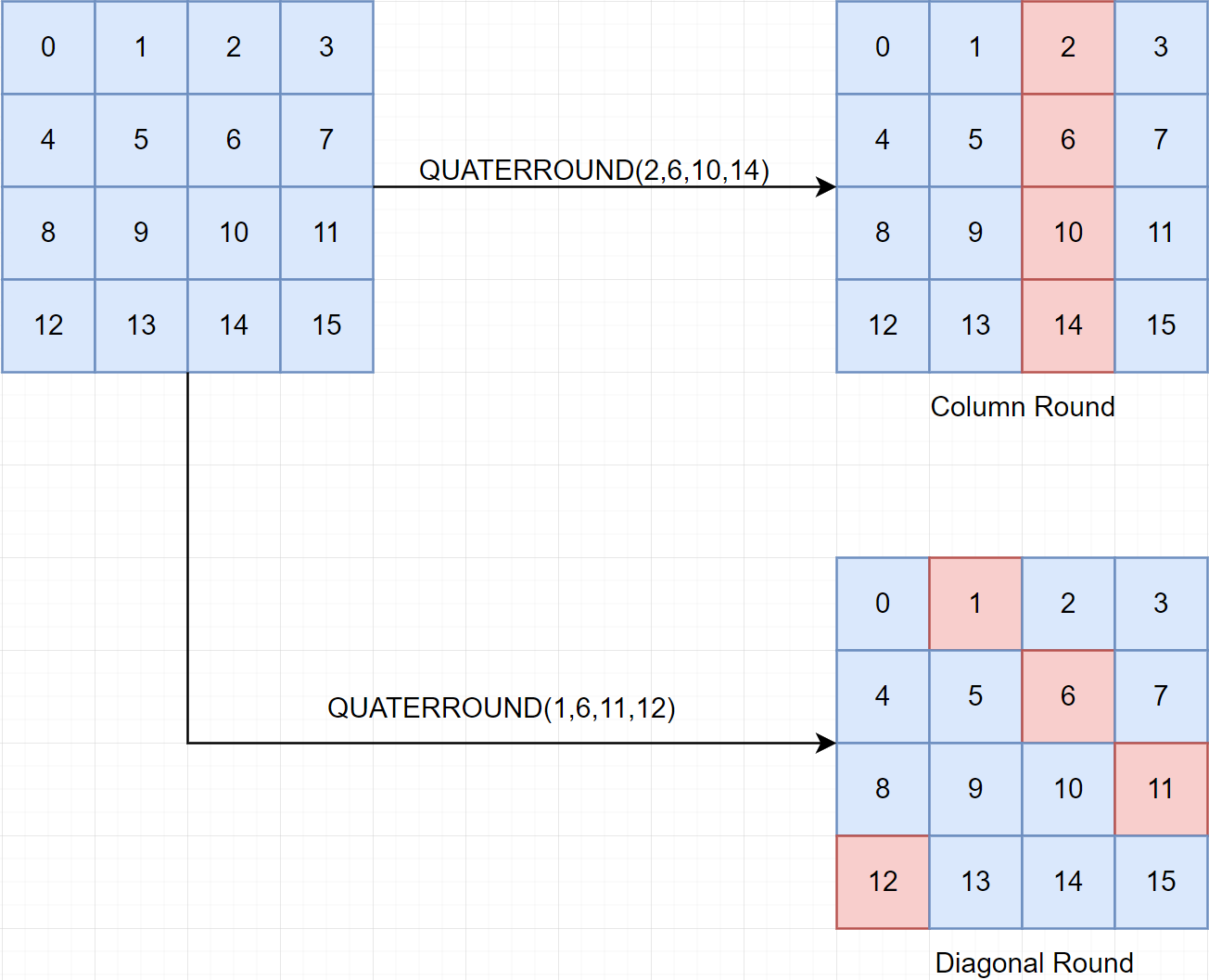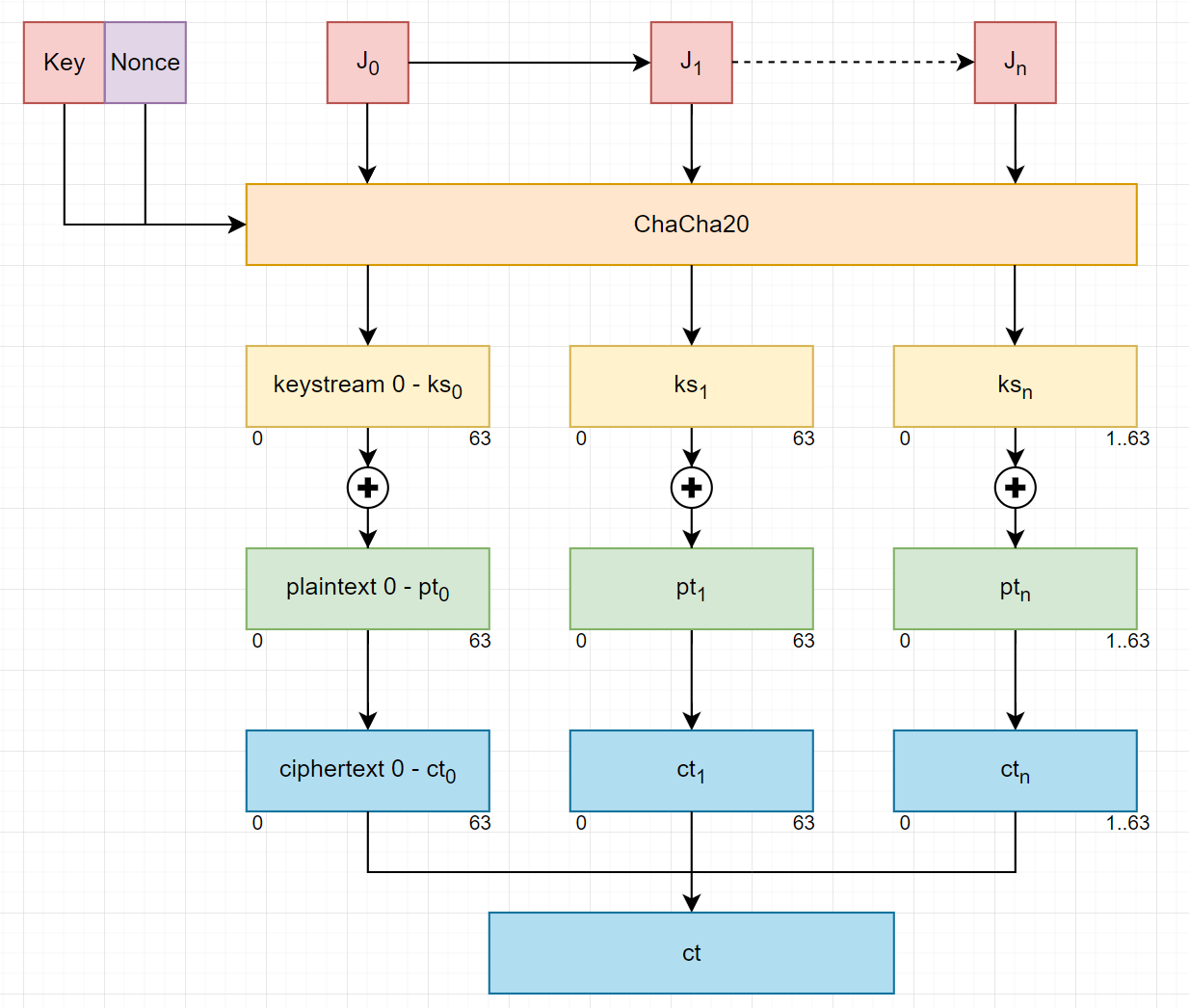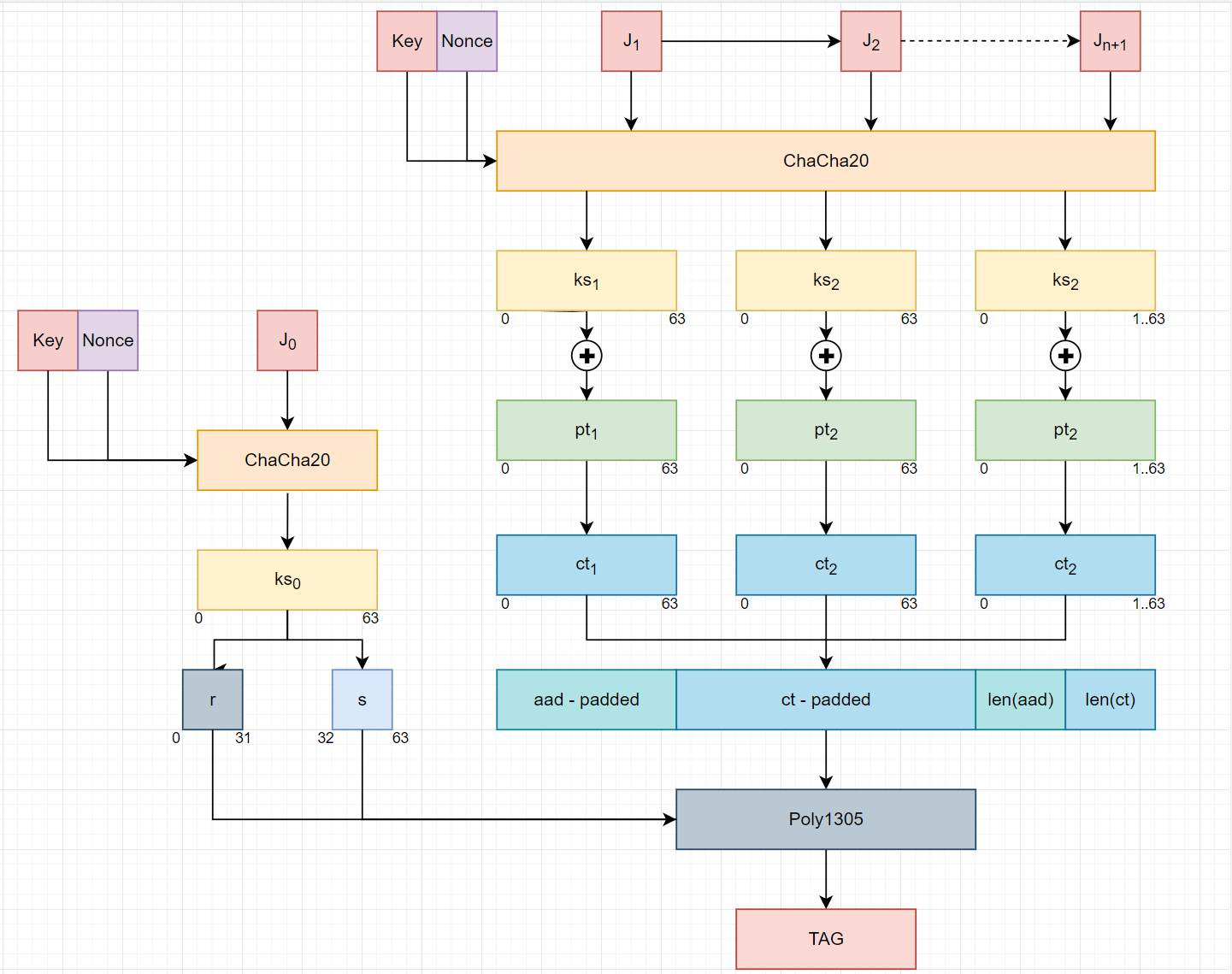ChaCha20-Poly1305 and Nonce reuse attack
Introduction to the cipher and attack.
Background
When doing picoCTF 2025, I encountered a challenge that requires to forge a TAG for a AEAD cipher ChaCha20-Poly1305 with a reused key and nonce. This post is a summary of the cipher and the attack.
ChaCha20-Poly1305
Like AES-GCM, ChaCha20-Poly1305 have two components: a encryption cipher and a tag generation part.
ChaCha20
ChaCha20 can be understood as a 20 rounds (80 quarter rounds) variant of ChaCha cipher - a stream cipher. It takes a 256-bit key, a 96-bit nonce, and a 32-bit counter to generate a keystream. The keystream is then xored with the plaintext to produce the ciphertext.
Internal
Quarter Round is the basic of Chacha cipher, which operate on 4 32-bit unsigned integers $a, b, c, d$ as follows, and denote as QUARTERROUND(a,b,c,d)
1
2
3
4
a += b; d ^= a; d = d << 16;
c += d; b ^= c; b = b << 12;
a += b; d ^= a; d = d << 8;
c += d; b ^= c; b = b << 7;
A state of ChaCha20 can be represented as 4x4 matrix of 32-bit unsigned integers.

ChaCha20 runs 20 rounds with alternating between column rounds and diagonal rounds. Below present of 2 rounds. So it will run 10 iterations for the list of rounds below.
1
2
3
4
5
6
7
8
9
10
11
12
13
14
15
16
17
18
19
20
inner_block (state):
QUARTERROUND(state, 0, 4, 8,12)
QUARTERROUND(state, 1, 5, 9,13)
QUARTERROUND(state, 2, 6,10,14)
QUARTERROUND(state, 3, 7,11,15)
QUARTERROUND(state, 0, 5,10,15)
QUARTERROUND(state, 1, 6,11,12)
QUARTERROUND(state, 2, 7, 8,13)
QUARTERROUND(state, 3, 4, 9,14)
end
chacha20_block(key, counter, nonce):
state = constants | key | counter | nonce
working_state = state
for i=1 upto 10
inner_block(working_state)
end
state += working_state
return serialize(state)
end
Encryption
Because ChaCha20 is a stream cipher decryption is the same as encryption.
- Input:
- Key: 256-bit key.
- Nonce: 96-bit nonce.
- Counter $(J)$: 32-bit counter. In ChaCha20-Poly1305, the counter is set to 1 because block 0 is used to derive $(r,s)$ for Poly1305.
- Plaintext: arbitrary length plaintext.
- Output:
- Ciphertext: same length as plaintext.
Note: all number in figure are for (0 .. 63) bytes = 512 bits.
- In pesudo code:
1
2
3
4
5
6
7
8
9
10
11
12
13
14
chacha20_encrypt(key, counter, nonce, plaintext):
for j = 0 upto floor(len(plaintext)/64)-1
key_stream = chacha20_block(key, counter+j, nonce)
block = plaintext[(j*64)..(j*64+63)]
encrypted_message += block ^ key_stream
end
if ((len(plaintext) % 64) != 0)
j = floor(len(plaintext)/64)
key_stream = chacha20_block(key, counter+j, nonce)
block = plaintext[(j*64)..len(plaintext)-1]
encrypted_message += (block^key_stream)[0..len(plaintext)%64]
end
return encrypted_message
end
Poly1305
The original Poly1305 first appear in The Poly1305-AES message-authentication code. Briefly, It a MAC function requires 2 128-bits keys, and 1 128-bits nonce. AES used 1 key to encrypt nonce and compile with another key to have a pair $(r,s)$.
The pair $(r,s)$ must be unpredictable and follow the standard below. Here $r$ is treated as 16-octet little-endian number because of $C$ limitation.
-
r[3], r[7], r[11], and r[15] are required to have their top four bits clear (be smaller than 16)
-
r[4], r[8], and r[12] are required to have their bottom two bits clear (be divisible by 4)
And the Poly1305 function is as follow, because $msg$ when going into poly1305 have been padded to a multiple of 16 bytes so we don’t consider last block < 16 bytes.
1
2
3
4
5
6
7
8
9
10
11
12
13
14
15
def poly1305(r,s,msg):
def clamp(r):
r &= 0x0ffffffc0ffffffc0ffffffc0fffffff
return r
a = 0
r = clamp(r)
p = (1<<130)-5
for i in range(0,len(msg),16):
block = msg[i:i+16]
assert len(block) == 16
n = le_bytes_to_num(block + b'\x01')
a+=n
a = (r*a)%p
a+=s
return (a % (1 << 128)).to_bytes(16,'little')
So the Poly1305 function can be written as
\[Poly1305(r,s,msg) = ((block_1*r^i + block_2*r^{i-1} + .. + block_i*r^1) \; mod \; (2^{130}-5) + s) \; mod \; 2^{128}\]$(r,s)$ pair generation for ChaCha20 is simple as follow.
1
2
3
4
def poly1305_key_gen(key,nonce):
cipher = ChaCha20.new(key=key, nonce=nonce)
ks = cipher.encrypt(b'\x00'*32)
return ks[:16],ks[16:] #(r,s) in bytes -> need to convert to le int
ChaCha20-Poly1305 encryption/decryption.
Here is sanity check script.
Reuse Nonce attack:
In Oracle scheme, The key is often reused for multiple messages, but when Nonce is reused, we will have 2 $ct$ and $tag$ pairs from the same $(r,s)$ pairs
\(tag_1 = Poly1305(r,s,pad(ct_1)) = ((block_{1,1}*r^i + block_{1,2}*r^{i-1} + .. + block_{1,i}*r^1) \; mod \; (2^{130}-5)) + s \; mod \; 2^{128}\) \(tag_2 = Poly1305(r,s,pad(ct_2)) = ((block_{2,1}*r^i + block_{2,2}*r^{i-1} + .. + block_{2,i}*r^1) \; mod \; (2^{130}-5)) + s \; mod \; 2^{128}\) \(tag_1 - tag_2 = (r^i*A_1 + r^{i-1}* A_2+ .. + r^1 * A_i) \; mod \; (2^{130}-5) \; mod \; 2^{128} \; ; \; A_i = (block_{1,i} - block_{2,i})\) \(tag_1 - tag_2 = (r^i*A_1 + r^{i-1}* A_2+ .. + r^1 * A_i) \; + k*2^{128} \; mod \; (2^{130}-5) ; \; k \in {-4,4}\)
From this we can recover $r$ easily and check if $r$ is correct by using clamp function and derive $s$ from $tag_1$ and $tag_2$ and check if equal. From $r,s$ we can forge a tag for any message using the keystream generated from ChaCha20.
Example.
Challenge ChaCha Slide in picoCTF 2025: We are given 2 pair (ct,tag) - known plaintext to get the keystream, and we need to forge a tag for a new message.
1
2
3
4
5
6
7
8
9
10
11
12
13
14
15
16
17
18
19
20
21
22
23
24
25
26
27
28
29
30
31
32
33
34
35
36
37
38
39
40
41
42
43
44
45
46
47
48
49
50
51
52
53
54
55
56
57
58
59
60
61
62
63
64
65
66
67
68
69
70
71
72
73
74
75
76
77
78
79
80
81
82
83
84
85
86
87
88
89
90
91
92
93
94
95
96
97
98
99
100
101
from pwn import *
from sage.all import *
def le_to_little_endian_pad(length: int) -> str:
return length.to_bytes(8, 'little')
def le_bytes_to_num(b: bytes) -> int:
return int.from_bytes(b, 'little')
def pad_to_16(data: bytes) -> bytes:
if data == b'':
return b''
return data + b'\x00'*(16-len(data)%16)
def padding(data: bytes,aad: bytes) -> bytes:
return pad_to_16(aad) + pad_to_16(data) +le_to_little_endian_pad(len(aad))+le_to_little_endian_pad(len(data))
def clamp(r):
r &= 0x0ffffffc0ffffffc0ffffffc0fffffff
return r
def poly1305_symbolic(r,s,data):
a = 0
for i in range(0,len(data),16):
block = data[i:i+16]
n = le_bytes_to_num(block + b'\x01')
a+=n
a = (r*a)
a+=s
return a
def poly1305_normal(r,s,data):
a = 0
p = (1<<130)-5
for i in range(0,len(data),16):
block = data[i:i+16]
n = le_bytes_to_num(block + b'\x01')
a+=n
a = (r*a)%p
a+=s
return a
io = process(['python3', 'challenge.py'])
io.recvuntil(b'(hex):')
pt1 = bytes.fromhex(io.recvline().strip().decode())
io.recvuntil(b'(hex):')
ct1 = bytes.fromhex(io.recvline().strip().decode())
io.recvuntil(b'(hex):')
pt2 = bytes.fromhex(io.recvline().strip().decode())
io.recvuntil(b'(hex):')
ct2 = bytes.fromhex(io.recvline().strip().decode())
ciphertext1 = ct1[:-28]
tag1 = ct1[-28:-12]
nonce1 = ct1[-12:]
ciphertext2 = ct2[:-28]
tag2 = ct2[-28:-12]
nonce2 = ct2[-12:]
assert nonce1 == nonce2
C1 = padding(ciphertext1,b'')
C2 = padding(ciphertext2,b'')
p = 2**130 - 5
K = Zmod(p)
PR = PolynomialRing(K, 'r')
r = PR.gen()
T1 = le_bytes_to_num(tag1)
T2 = le_bytes_to_num(tag2)
x1 = poly1305_symbolic(r, 0, C1)
x2 = poly1305_symbolic(r, 0, C2)
res = []
f = (x1-x2)
for k in range(-4,4):
A = T1-T2+k*2**128
f_ = A-f
for r,_ in f_.roots():
if clamp(int(r)) == int(r):
s = (T1 - int(x1(r))) % 2**128
s2 = (T2 - int(x2(r))) % 2**128
if s == s2:
res.append((int(r),s))
r,s = res[0]
# sanity check
assert poly1305_normal(r,s,C1) % 2**128== T1
assert poly1305_normal(r,s,C2) % 2**128 == T2
ks1 = xor(ciphertext1,pt1)
goal = "But it's only secure if used correctly!"
goal=goal.encode()
ct_goal = xor(ks1[:len(goal)],goal)
C3 = padding(ct_goal,b'')
tag = poly1305_normal(r,s,C3)
tag = (tag % (1 << 128)).to_bytes(16,'little')
CT = ct_goal + tag + nonce1
io.sendline(CT.hex())
io.interactive()
#picoCTF{7urn_17_84ck_n0w_77243c82}
References
- ChaCha20 and Poly1305 for IETF Protocols
- Introduction to ChaCha20 and Poly1305.

